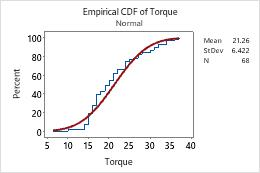
Now instead of multiple samples at each level graded as a pass or fail, we are running each sample through each level and recording the value at which it fails. Thanks Mark, I’ve been also working with Jonathan Mann and the sample sizes that we have been calculating have been in the order of 1000’s and so we have adjusted the analysis in an effort to make the data more continuous. Note that estimates of variance need lots of data to be accurate. In my example the test showed no difference in variance so I can feel that the approach of just subtracting 3.4 from the current LSL and USL is reasonable. We can test this statistically using Stat > ANOVA > Test for Equal Variance. That the variability of the process does not change from the “Before” to the “After” case.That if the process was brought on aim by raising the process from the observed 17.8 to 18 that the “Before” would also need to go up by 0.2 units.One way to set the “Before” specifications would be to say that you normally control to an aim of 18 for the “After” case and the treatment causes a rise of 3.4 units so you could set your limits for the before case to a LSL of 16 – 3.4 and the USL to 20 – 3.4. This is telling you that there is a difference between the 2 samples that is unlikely to be due to chance. You do your 2 sample t-test and get the following result: Lets say you have on aim process control with aim of 18 and specifications of +/- 2 units. I’ll make use an example to illustrate a potential approach. You are also looking to set specifications. To get reasonable results you need to have roughly normal distributions of the before and after data sets.

You have essentially a 2 sample t-test situation, however…Ī two sample t-test is looking to see if there is a statistical difference between the 2 sets of data in the mean value. This situation raises a number of questions. Let ‘MatchWtSum’ = pars(weight*(‘Criteria1’=’Criteria2’))Īfter these manipulations the worksheet would look like:Ĭriteria1 Weight Criteria2 MatchWt MatchWtSum Name C7 ‘MatchWtSum’ # Cummulative sum of weights with matching criteria Let ‘MatchWt’ = weight*(‘Criteria1’=’Criteria2’) Name C6 ‘MatchWt’ # Column with 0 for non match or weight if criteria match Once that is done the manipulations are straightforward:
#Minitab express ecdf graph how to#
See the post for How To > Data Manipulation > Padding columns. If the columns have different numbers of rows you need to pad them to equal length. In this example you would want to sum the weights for matching colours. If I’ve understood your question you have 3 columns, for example: Positive numbers but that is getting complicated!). This data you could plot the negative values but labels the ticks with (If you were creating a macro to routinely plot The only difference from the example is that the depths will be negative

Scatterplot with Y axis “on top”, along with data labels… I’m not that familiar with more than the basic data analysis add-in for Excel, but Minitab out of the box “excels” at graphical analysis. the ability to overlay distribution curves, the ability to sub-set the data graphed, smooth ability to handle missing data, etc.statistically powerful graphs – ECDF graphs, Box Plots, Individual Values Plots, Matrix Plots, etc.proper histograms without having to define bin ranges!.no need to adjust data ranges for graphs if your dataset grows.the ability to easily create panelled graphs and multiple graphs from one dialog.These opportunities are often solved in practical ways without the need for formal statistical methods.Ĭonsider the benefits Minitab brings to graphical analysis: From my experience in manufacturing, graphical methods uncover most of the opportunities which get pursued. Graphical analysis is at the heart of the practice of statistics.

Here are some thoughts I posted in another forum: One example is the power of the “word” function mentioned in the previous post. If you are “fluent” in both you may find yourself using Minitab more than you thought for data manipulation. I am a fan of Minitab(r) and Excel(r) but which to use?


 0 kommentar(er)
0 kommentar(er)
